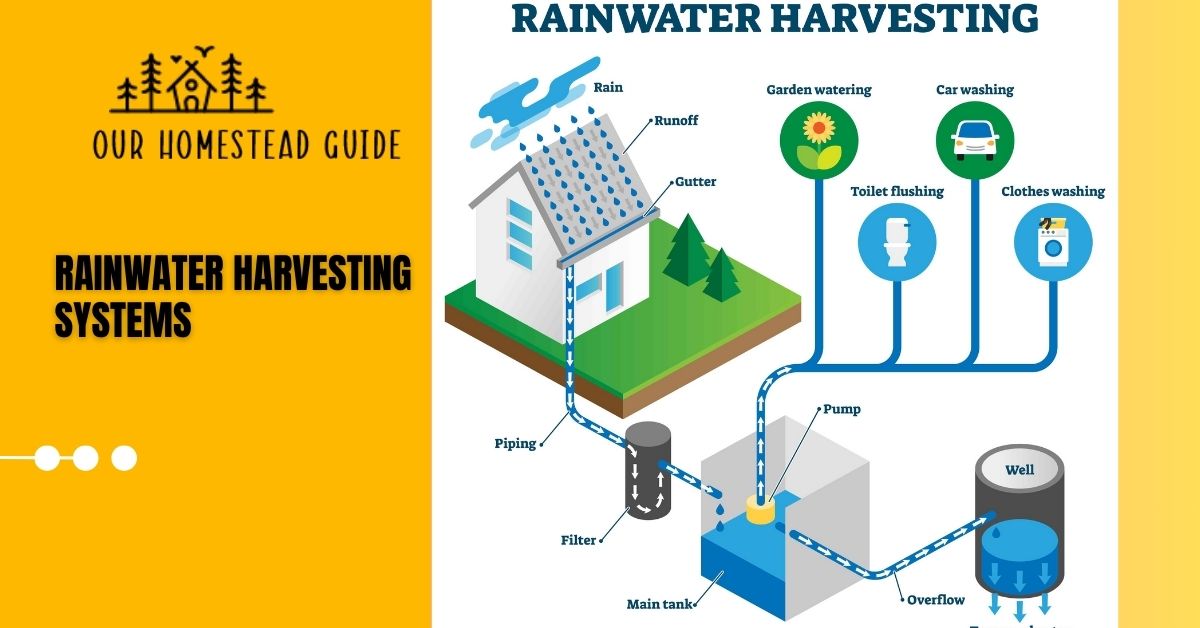Rainwater Harvesting Systems: Complete Process
Rainwater harvesting systems are a great way to conserve water and reduce your reliance on municipal supplies. Rainwater is collected from your roof, filtered, and then stored in a tank for future use. Rainwater collection may be used for many different things, such as cleaning your car, flushing the toilet, and watering your garden.
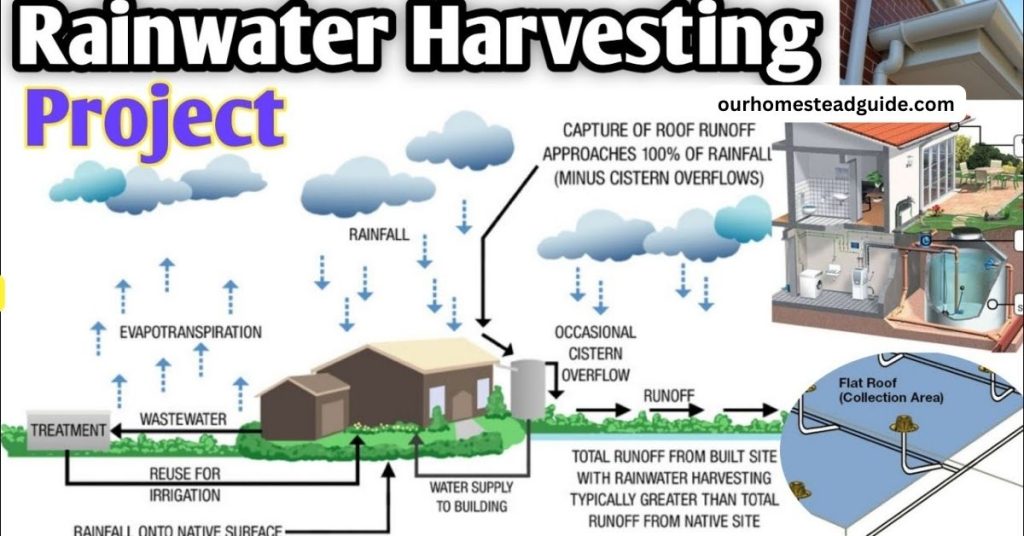
Rainwater harvesting systems come in two primary varieties: basic and complicated. While elaborate ones require pumps, filters, and even drinking water purification, simple ones employ rain buckets. Both protect the environment and save money!
Considerations Before Installation:
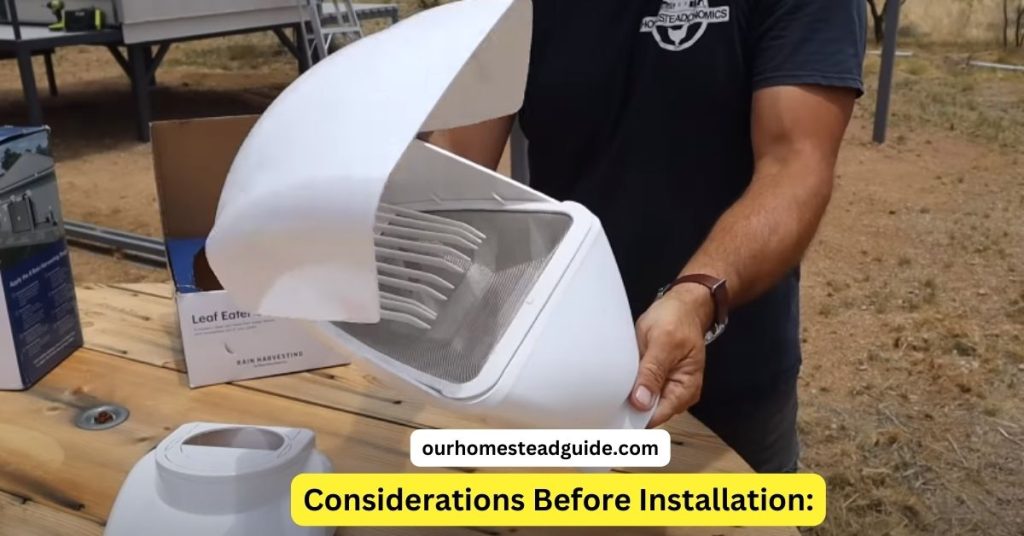
Determine why you want to collect rainwater (e.g., for gardening, landscaping, or as your main supply of water).
To make sure the roofing material is appropriate for using potable water, consider its kind (metal, tile, slate, asphalt, etc.).
Choose the water tank’s placement while taking the downspout system type (direct pipe technique or dry pipe, for example) into account.
When determining where to put a tank, take sandy or erosion-prone soils into account.
Gutter Installation:
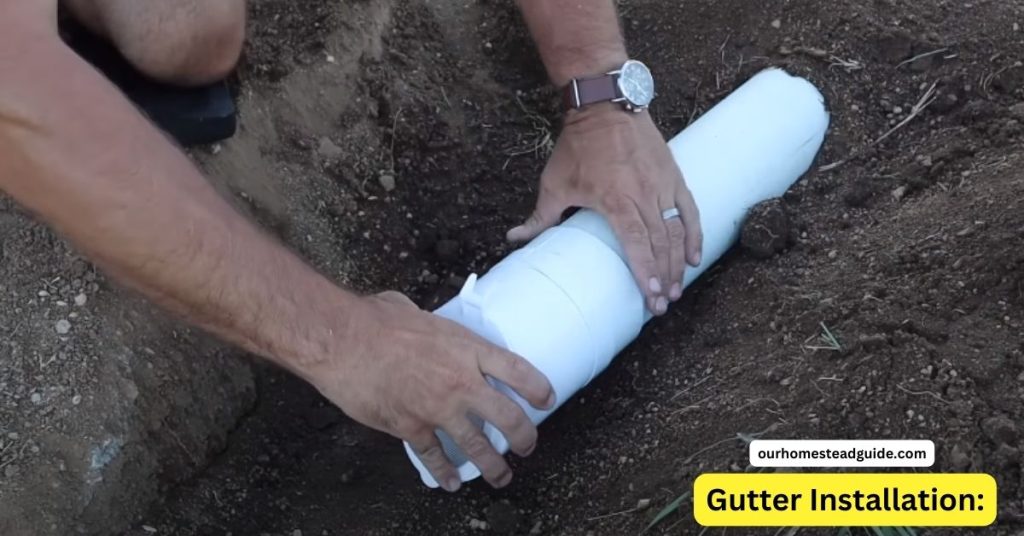
| Task | Description |
|---|---|
| Install Gutter | Standard 4-inch gutters (or 5-6 inch for larger structures) to be installed on the collection structure. |
| Ensure Proper Slope | Maintain a slight slope during installation to ensure efficient water flow within the gutters. |
| Level Bottom of Gutters | Ensure the bottom of the gutters is leveled properly to maximize water-holding capacity. |
| Adjust for Fascia Board Angles | Address any fascia board angles by using screws to adjust the gutter’s alignment accordingly. |
Downspout Installation:
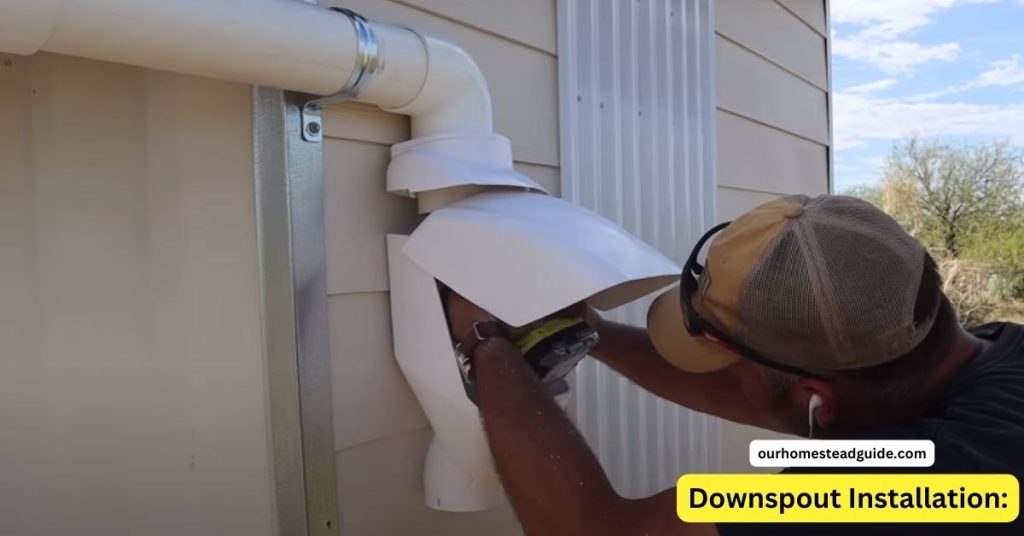
Place the downspouts where you want the leaf and debris filter to be.
To make leaf filter maintenance easier, leave a space of 5 to 6 inches below the last joint.
Leaf and Debris Filter Installation:
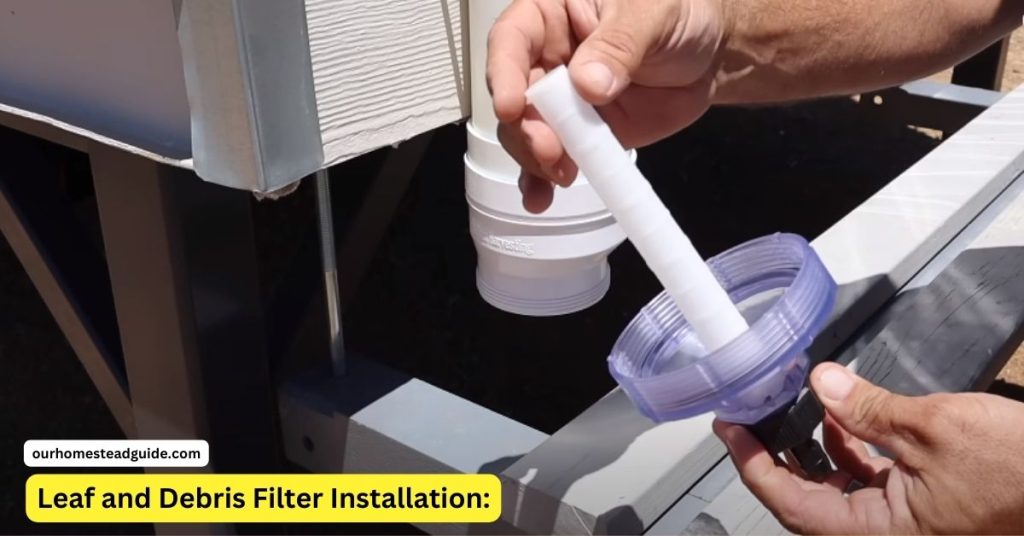
- On the downspout, install the leaf and debris filter.
- Describe the filter’s function and walk through how it cleans.
- Stress how crucial it is to stop nesting and the ingress of waste.
First Flush Component Installation:
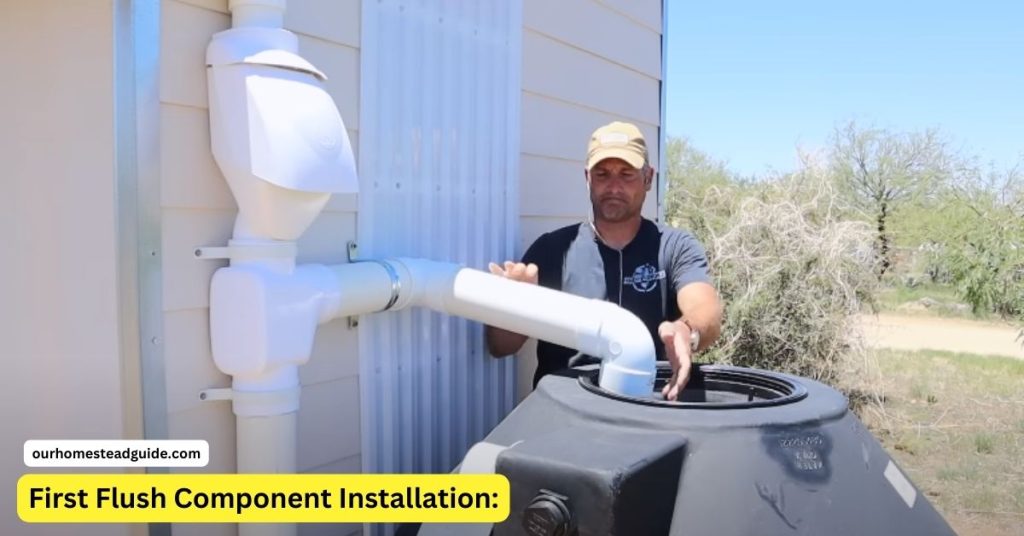
Put the first flush chamber together, including the outputs and inlets.
Describe the function of the conical insert, which separates filthy and pure water.
Show how to install the lower part that collects the contaminated water.
High Water Level Overflow Kit Installation:
Affix the high water level overflow kit to the elevated side of the tank.
Describe the goal of avoiding possible erosion and overflow.
Display the screened outlet designed to divert excess water away from the building.
Valve Setup:
Show off the valve assembly that is included with the package.
Describe the many ways to connect to a garden hose or irrigation system.
Show how to install PVC fittings so that the water flows properly.
Water Level Gauge Installation:
On top of the tank, drill a 1.25-inch hole for the water level gauge.
To indicate the empty and full tank levels, insert the float and adjust the indicator.
Examine the water level gauge’s operation.
Final Adjustments and Backfilling:
- Make sure every part is firmly fixed.
- Refill any sections that were dug out.
- Rocks or landscaping might be added just decoratively.
Rainwater Harvesting: Advantages and Disadvantages
| Feature | Advantage | Disadvantage |
|---|---|---|
| Water Usage | Reduces reliance on municipal supply and overall water consumption. | Limited storage capacity can lead to depletion during dry periods. |
| Cost Savings | Lowers water bills by using rainwater for non-potable purposes. | Initial investment for equipment and installation can be high. |
| Environmental Benefits | Reduces stormwater runoff, prevents erosion and flooding, and replenishes groundwater. | Requires regular maintenance to ensure water quality and system efficiency. |
| Independence | Provides an alternative water source, increasing resilience against shortages. | Local regulations may restrict or require permitting for rainwater harvesting. |
| Water Quality | Rainwater is generally softer and free of chemicals, potentially benefiting skin and hair health. | May not be suitable for drinking without additional treatment depending on roof material and filtration system. |
Additional Considerations:
Catchment Area: The amount of water collected depends on the size of the roof or other defined area.
Climate: The amount of rainfall affects how well a system works and how much storage is required.
Maintenance: For best results, regular cleaning and maintenance are required.
Local Regulations: Before installation, confirm any applicable area policies and limitations.
Technology Considerations for Rainwater Harvesting Systems
The intricacy of your system and its intended purpose will determine the range of technological alternatives available for rainwater collection systems. Here are some important things to think about:
Collection:
Roofing Material: The compatibility of different materials (such as clay, asphalt, and metal) with the collection of drinkable water varies. Make sure the material of your roof is appropriate for the water you want to utilize.
Leaf filters and screens: By keeping organic material out of the system, they lower the need for maintenance.
First flush diverters: By rerouting the first, more polluted rainfall, they enhance the quality of the water.
Storage:
- Select a sturdy and appropriate material for the tank, such as concrete, fiberglass, or polyethylene. Take into account elements like price, longevity, and possible chemical leakage.
- Tank Size This is determined by your consumption patterns, anticipated rainfall, and the availability of a backup water source. Larger tanks need more room and money, but they offer greater buffer.
- Overflow Protection Use automated shutdown systems or bypass valves to stop tank overflow.
Treatment:
Filtration: For certain needs, such as drinking water, many steps of filtration (sediment, carbon, and reverse osmosis) may be required.
Disinfection: To get rid of dangerous germs, disinfect drinkable water with UV light or chlorinate it.
Water Testing: If water is to be used for drinking or other sensitive uses, it must undergo routine testing to ensure its purity.
Distribution:
Pressure systems and pumps could be required to transport water to greater altitudes or certain locations.
Pipes and Valves Select materials that are suitable with rainwater and your intended purpose, like as copper or PVC.
Backflow Prevention To stop tainted water from getting into the municipal water system, install backflow prevention devices.
Additional Technologies:
Monitoring Systems and Sensors: Monitor water quality, tank temperature, and levels in real-time.
Smart Irrigation Systems: Using soil moisture and meteorological data, these systems irrigate your garden or lawn automatically.
Software for rainfall Harvesting: You may use tools to plan your system, measure water use, and assess your potential for rainfall.
System Sizing Rainwater Harvesting Systems
Rainwater harvesting systems can be as basic as barrels or as sophisticated as multi-tank systems. The following variables will determine the amount of system you require:
- The typical rainfall in your location
- The extent of your catchment area or roof
- Your requirements for water consumption
The following are some broad recommendations for rainwater collecting system sizing:
- A fifty-gallon rain barrel will do simple tasks like washing your car or watering your plants.
To utilize rainwater for washing or toilet flushing, a bigger system that can hold 500–1,000 gallons or more is required. - You could want an even bigger system, with a storage capacity of several thousand gallons, for off-grid living or locations with restricted access to water.
After estimating the approximate size of your system, you must select the appropriate parts. Among them are:
- a catchment region, like your roof or a surface set aside for collecting rainwater.
- Rainwater may be sent to your storage tank by gutters and downspouts.
- A storage tank composed of fiberglass, concrete, or plastic.
- To get the water from the tank to your point of usage, utilize a pump or gravity system.
- filters to rid the rainwater of particles and contaminants.
System Components of Rainwater Harvesting Systems
For rainwater harvesting systems to efficiently collect, store, and use rainfall, they need a few essential parts. Below is a summary of the key components:
Catchment Surface:
- This is where rainwater is gathered; it’s usually the building’s roof or a specially set-aside area on the ground.
- Potable water use is typically acceptable on slate, clay tile, and metal roofs; treated wood and asphalt shingles are not advised.
Conveyance System:
The rainwater collection system directs it in the direction of the storage tank. Typically, it consists of:
Water flow from the roof is captured and directed into the tank via gutters and downspouts.
First-flush or leaf diverters They deflect the first runoff of filthy water off the roof so that the rainfall that has been retained isn’t contaminated.
Filtration System:
Rainwater collected is purified using filters to eliminate particles and contaminants. The intended usage determines the degree of filtration to be used:
Basic mesh filters are appropriate for non-potable applications like cleaning cars or gardening.
Sediment filters Eliminate bigger particles such as leaves and sand.
Carbon filters Enhance flavor and odor while getting rid of organic debris.
The highest degree of filtration for usage in potable water is provided by reverse osmosis.
Storage Tank:
The rainwater collection is kept in this tank. Things to think about:
Material: Fiberglass, steel, concrete, and polyethylene are among the options. Each has benefits and drawbacks related to cost, durability, and aesthetics.
Size: This relies on the size of the catchment area and your demands. Though they take up more room, larger tanks offer greater storage.
Location: Either above or below earth is possible. Although they cost more to build, underground tanks protect from the heat and cold temperatures.
Distribution System:
You can use the rainwater that has been saved thanks to this setup. Among the options are gravity-fed systems, which use gravity instead of a pump to distribute water to different locations.
Pumping system: Good for getting to higher altitudes or getting a lot of water.
Overflow Mechanism:
The tank is kept from overflowing during periods of intense rainfall by an overflow pipe. It diverts extra water away from the foundation and tank.
Additional Components:
Float valves: Control the tank’s water level and stop overflows.
Pumps and controllers: Used to automate water transfer or distribute pressured media.
Water treatment systems: These may be required for the usage of potable water, and they may include UV or chlorination.
Rooftop Rainwater Harvesting
A sustainable and environmentally beneficial method, rooftop rainwater collection uses rain as a natural resource for a variety of uses. During this procedure, a building’s roof acts as a collection surface, sending rainwater to a storage system via gutters and downspouts.
First-flush diverters and filter systems are frequently used to remove debris and contaminants from the initial rain flow to improve the quality of the water. The size of the tanks or cisterns used to hold the collected rainwater is determined by variables such as roof area and regional rainfall trends.
By making sure that extra water is securely redirected, an overflow system guards against possible harm. Rainwater collecting from rooftops is especially useful in areas where there is a shortage of water since it offers a decentralized, sustainable source of water for landscaping, irrigation, and, with the right preparation, even home usage.
This approach helps lessen the negative effects of urbanization on regional water systems while also conserving water supplies.
Operation and Maintenance of Rainwater Harvesting Systems:
It takes frequent maintenance to keep your rainwater harvesting system operating securely and properly. The following is a guide to fundamental upkeep and operating procedures:
Operation:
Water usage: To guarantee a sufficient supply and avoid overflow, keep an eye on how much water you use and monitor the tank level. If necessary, modify your consumption habits or add more from municipal sources.
Filters: Clean filters regularly according to the water quality and manufacturer’s directions. This keeps plugging away and guarantees effective filtration.
Pumps and valves: Periodically check that the pumps and valves are operating properly. Check for leaks and fix any issues right away.
Overflow mechanism: To avoid tank overflow and possible damage, make sure the overflow pipe is free of obstructions and clear.
Maintenance:
Roof and gutters: Check for damage, leaks, and debris on your roof and gutters. To keep the water flowing effectively, remove leaves and twigs regularly.
Tank cleaning: Based on consumption and the quality of the local water, schedule recurring tank cleanings. In addition to removing silt, this stops bacterial development.
integrity of the system: Examine the tank itself, the connections, and the pipes for leaks or cracks. Take quick action to repair any damage to avoid structural problems and water loss.
Winterization: To prevent freezing and burst pipes in cold areas, drain or appropriately winterize pumps and pipelines.
Record-keeping: For future reference, keep track of all maintenance assignments, water use, and filter replacements.
Additional Tips:
To conveniently keep an eye on the tank level, use a sight gauge or water level indicator.
Think of implementing automated systems for filter cleaning reminders, overflow alarms, and pump control.
Learn about the rules and safety precautions that apply to rainwater collection in your area.
See a trained expert if you have any questions regarding any maintenance procedures.
Most Frequently Asked Questions!
1. Why should I consider installing a rainwater harvesting system?
With the help of rainwater harvesting, you may gather and store rainfall, making it an affordable and sustainable resource for gardening, landscaping, and in some situations, even as a main supply of water. It promotes water conservation and lessens reliance on municipal water supply.
2. What components are typically included in a rainwater harvesting kit?
Guttering, downspouts, leaf and debris filters, first flush parts, high water level overflow kits, valves, and a water level gauge are some of the items that a typical rainwater collecting kit could contain. The particular parts may change depending on the kit and its intended use.
3. Can I use rainwater harvested from any type of roof?
Although rainwater may be collected from several kinds of roofs, materials such as slate, tile, or metal work better for producing drinkable water. It is essential to conduct further study before using asphalt or emulsion roofs for non-potable uses.
4. How do I determine the size of the rainwater tank I need?
The amount of water you use and the frequency of rainfall determine the tank’s size. Take into account the roof’s area, the area’s typical rainfall, and how the collected water will be used. Though they take up more room, larger tanks have a higher storage capacity.
5. What is the purpose of the first flush component in the system?
The first flush system collects rainfall that may include surface pollutants from the roof. By rerouting this “first flush” of water, it guarantees that the collected water is of a better caliber.
6. How do I prevent the overflow of the rainwater tank?
When the tank is full, an overflow kit for high water levels is added to allow extra water to escape. In addition to directing the water to the targeted area, this stops overflow and possible erosion.
7. Can I use the harvested rainwater for drinking and cooking?
You can utilize harvested rainwater for cooking and drinking if the system is made for potable water consumption and your roof material is compatible. Make sure the system uses the right purification and filtration techniques.
8. How often do I need to maintain the system?
Gutter cleaning, filter inspections, and component check-ups are all part of routine maintenance. The frequency is influenced by the environment and debris presence in the area. An effectively managed system performs well.
9. Are rainwater harvesting systems environmentally friendly?
Because it encourages water conservation, lessens the strain on conventional water sources, and limits stormwater runoff, rainwater collecting is indeed seen to be ecologically favorable.
10. Where can I find additional resources and information about rainwater harvesting?
Important materials and information may be found on websites run by local water authorities, groups advocating for sustainable practices, and companies making rainwater collecting systems, such as tankdepot.com.
you may also like this article.

